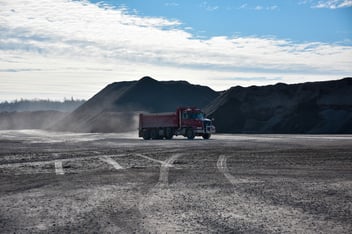Safe and Efficient Construction Waste Disposal Guide
Whether you’re paving roads, building skyscrapers, or renovating an existing structure, waste is an inevitable part of any construction project. According to the EPA, construction activities across the United States generated 600 million tons of waste in 2018, which is more than double the amount of solid waste generated by municipalities.
Not only do construction activities generate huge amounts of waste, a lot of that debris gets sent to landfills — 145 million tons in 2018, in fact. Because of the high costs of construction waste to the environment, as well as construction companies and their customers, safe and efficient construction waste disposal needs to be a key consideration for every contractor and site supervisor — from planning through to project completion.
What is considered to be construction waste?
Construction waste, often referred to more broadly as construction and demolition waste (CDW), is considered to be all of the leftover materials and debris produced by construction and demolition activities.
Construction waste varies depending on the type of project and the job site but can consist of a variety of materials ranging from brick, wood, and glass to insulation, pipes, topsoil, and concrete.
Types of construction waste
Construction waste can generally be classified into three broad categories:
Building materials
As the name suggests, building material waste comes from the construction and renovation of buildings and other structures. Building material waste is typically the result of unused or damaged materials such as wood, drywall, bricks, wiring, and nails.
Demolition waste
Demolition waste consists of all the debris from a demolition project. It usually consists of both hazardous materials (most notably, asbestos) and building materials such as concrete, metal, wood, glass, and tiles. While hazardous debris needs to be carefully handled and disposed of, non-hazardous demolition debris can often be recycled or reused at a future point in the project.
Out of the 600 million tons of construction and demolition waste generated in the United States in 2018, more than 90% of it came from demolition.
Hazardous waste
Hazardous waste encompasses all of the treated materials and leftover supplies that contain hazardous substances. Asbestos, specially treated wood, leftover paint, adhesives, and other chemicals (and their containers, due to the lingering contaminants) are all common types of hazardous construction waste. Dredging materials from contaminated sites (such as the demolition of an industrial building) can also be considered hazardous waste and need to be disposed of accordingly.
Before any construction or demolition project begins, it’s important to identify the types of waste that will be produced, identify recycling options, and create plans for their handling and disposal.
How is construction waste disposed of?
When most people think of construction waste disposal, they envision a dumpster full of building materials ready to head to the landfill. In reality, the process depends largely on the type of waste involved as well as the extent to which these materials can be reused or recycled.
Building material waste disposal
Building material waste can often avoid disposal by being reused on-site instead. Reusing or recycling construction materials is not only great for the environment by cutting down on waste sent to landfills, it can also create significant cost savings.
Unused materials in good condition may be able to be used for future tasks in lieu of purchasing more products, such as paint, wood, and nails. Some materials, such as concrete, can be crushed for future use, while steel and other metals can be melted down and reformed.
Any building material waste that can’t be reused on-site can be placed in a container for collection by a waste management company or transported to a landfill or recycling facility.
Demolition waste disposal
Similar to building materials, demolition waste can often be recycled. Sorting demolition debris to allow for recycling can be time consuming, but it can lead to cost savings and is better for the environment than sending it, unsorted, to a waste facility.
Demolition debris can contain hazardous materials, most notably asbestos, which requires careful handling and disposal to prevent adverse health effects. When handling and disposing of asbestos—or any other hazardous demolition debris—make sure to follow any relevant laws and regulations in your jurisdiction and bring in the services of a licensed specialist or waste removal company where required.
Hazardous construction waste disposal
Hazardous construction waste, whether it’s materials containing asbestos or simply a leftover can of paint, requires careful storage, handling, and disposal to prevent harm to workers as well as the environment. Hazardous waste disposal processes vary depending on the material and must be done in accordance with local legislation; neglecting to follow these rules can lead to hefty fines, project delays, or other punishments.
How to improve your construction waste disposal process
As you’ve already learned, the process for disposing of construction and demolition waste varies greatly depending on the type of construction, the location of the construction site, and the rules dictating hazardous waste disposal for your region.
Despite all of these intricacies, here are some strategies that any team can take into account to improve their construction waste disposal process:
1. Develop a construction waste disposal plan from the start
Construction waste disposal needs to be considered well before materials arrive on site.
A waste disposal plan should evaluate:
- Which materials will be used and are most likely to become waste
- How waste generation will vary depending on the phase of the project
- How waste will be handled and stored on site
- How waste will ultimately be removed and disposed of
It should also clearly outline who is responsible for waste management and the protocols they will be expected to abide by and enforce.
Your waste disposal plan should be developed not only with efficiency in mind, but worker and environmental safety as well. Make sure that your plan is in line with all local, regional, and federal guidelines, along with any industry regulations or certification programs such as LEED. You can also set guidelines and goals for diversion or other desired performance indicators.
Execute regular waste audits
Particularly for long-term projects, waste audits should be performed at regular intervals to ensure the construction team and subcontractors are adhering to the identified strategies and protocols. These reviews can serve to adjust the construction waste recycling and disposal plan as necessary, based on any changes to the project. They also help identify new areas of concern or opportunities for recycling or reuse that were not evident in the initial planning stages.
2. Perform source separation on-site
Source separation is the process of segregating waste by the type of material. This can create cost savings down the line and is better for the environment because the sooner it’s completed in the disposal process, the greater the likelihood that construction waste materials can be diverted from the landfill through reuse or recycling.
Unfortunately, this isn’t always the case on construction sites because it takes less time for workers to simply dispose of all materials in the same containers, there isn’t always enough storage space to store separated materials, and the handling and removal of source materials can be more time-intensive and expensive. Allocating your team the time and space for source separation and outlining who is responsible for it may take some additional time and expense on the jobsite, but ultimately leads to a more efficient and environmentally friendly process overall.
3. Clearly outline waste disposal responsibilities for subcontractors
Subcontractor agreements should clearly outline the responsibilities that subcontractors have for waste produced on-site. Depending on the contract, they may be required to dispose of waste themselves or use on-site facilities and follow all existing procedures.
Regardless of where the responsibilities lie, clear communication of duties and protocols is important to ensure efficiency, worker safety, and adherence to environmental regulations.
4. Employ waste reduction strategies
While a robust waste disposal plan is important, the best way to make this process more efficient is to minimize the amount of waste generated in the first place.
Strategies that can be used on a construction site to reduce waste include:
- Invest in your material management process to prevent waste from excess or damaged materials.
- Use deconstruction and selective demolition methods when appropriate for demolition projects.
- Use off-site construction when possible to minimize material handling, and the subsequent waste, on the project site itself.
- Plan for the reuse and recycling of materials in later phases of the project where possible.
Whether we like it or not, construction projects of all sizes generate significant amounts of waste. Planning for disposal long before shovels even hit the ground will help minimize the amount of waste produced in the first place, divert as much of it as possible from landfills, and bring down the costs of hauling and disposal.
Use the tips above to plan, recycle and sort your way to more efficient waste management no matter the size of your project.
Tread can help with faster truck dispatch
That dumpster isn’t going to empty itself! Construction material waste can pile up quickly on a busy jobsite, so you need to get it moving to its final destination.
Tread’s dump truck dispatch management software can speed up your waste disposal process through faster and easier truck dispatching, e-ticketing, digital invoices and more.
Request a free demo now to discover what Tread has to offer.
Read On

Truck Driver Safety Incentive Program: 5 Key Practices
When you’re in charge of a truck fleet, driver safety should be paramount. As demands on truck...

13 fleet truck fuel management best practices
Fuel is the second-largest fleet-operating expense year after year. On average, it eats up 60% of a...

Five steps to moving forward along the road to digitalization
True digital transformation is a long-term commitment that affects every business sector: from...

